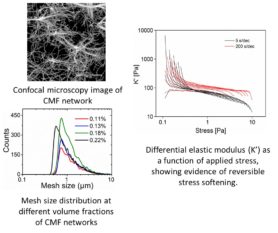
Srivatssan Mohan
Leonard S. Ornstein Laboratory, room 0.14
Princetonplein 1, 3584 CC Utrecht
P.O. Box 80 000, 3508 TA Utrecht
The Netherlands
phone: +31 (0)30 253 1287
secretariat: +31 (0)30 253 2952
e-mail: s.mohan@uu.nl
Research
Supervisors: Dr. Arnout Imhof and Dr. Krassimir Velikov
Promotor: Prof. dr. Alfons van Blaaderen
Funding: FOM
Employed: 1 May 2014 – 15 August 2018
Microfibrillar cellulose based marginal networks
A mechanically rigid structure attains a marginal state when it is stripped of all non-essential bonds, just before it ultimately loses its structural integrity and falls apart. Recent theoretical work has brought to light that, materials at the vicinity of their marginal state become highly sensitive; minute changes in temperature or state of stress are shown to have an enormous effect on their mechanical behavior [1,2]. This phenomena could lead to a new class of self-strengthening or healing materials [2,3].
The main aim of the project is to design and understand real-life marginal soft materials based on fibrous cellulose networks. Establishing a relationship between the network microstructure and its mechanical response would provide a lead to approach and define the marginal state. The first step towards that would be to discern the mechanical properties of these materials in relation to their structure. In this PhD project, state-of-the art tools like confocal microscopy, image analysis and rheometry are mainly used to investigate the properties of the system. It was found that the networks of CMF exhibit inelastic behaviour ie. the damages caused by an applied load are actually reversible and the reversible nature of the induced deformation was proportional to the rate of the applied stress.
The properties of double biopolymer networks comprising CMF and agarose, thus forming a thermo-reversible double-network gel were also investigated. Fundamental questions such as how the presence and the structure of one network influence the other and the composite system as a whole were of interest. We found an interesting result that the composite system shows a synergistic property enhancement compared to that of the constituting individual networks.
[1] V. Vitelli et al., Nature 480, 325-326 (2011)
[2] C. Broedersz et al., Nat. Physics 7, 983-988 (2011)
[3] M. Wyart et al., Phys. Rev. Lett., 101, 215501 (2008)

